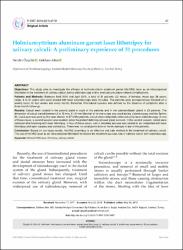| dc.contributor.author | Özçelik, Necdet | |
| dc.contributor.author | Altın, Gökhan | |
| dc.date.accessioned | 2020-09-16T13:07:53Z | |
| dc.date.available | 2020-09-16T13:07:53Z | |
| dc.date.issued | 2019 | en_US |
| dc.identifier.citation | Özçelik, N. ve Altın, G. (2019). Holmium:yttrium aluminum garnet laser lithotripsy for salivary calculi: A preliminary experience of 31 procedures. The Turkish Journal of Ear Nose and Throat, 29(1), 47-51. https://dx.doi.org/10.5606/Tr-ENT.2019.78871 | en_US |
| dc.identifier.issn | 2602-4837 | |
| dc.identifier.uri | https://dx.doi.org/10.5606/Tr-ENT.2019.78871 | |
| dc.identifier.uri | https://hdl.handle.net/20.500.12511/5829 | |
| dc.description.abstract | Objectives: This study aims to investigate the efficacy of holmium:yttrium aluminum garnet (Ho:YAG) laser as an intracorporeal lithotripter in the treatment of salivary calculi during sialendoscopy and to evaluate procedure-related complications. Patients and Methods: Between April 2014 and April 2016, a total of 31 patients (22 males, 9 females; mean age 38 years; range, 8 to 57 years) who were treated with laser sialendoscopy were included. The patients were postoperatively followed on a weekly basis for four weeks and every month, thereafter. Procedural success was defined as the absence of symptoms after a three-month follow-up. Results: Calculi were located in the parotid gland in eight of the patients and in the submandibular gland in 23 patients. The dimension of calculi varied between 2 to 12 mm. A 1.6 mm-Marchal all-in-one scope was used during sialendoscopy and the Sphinx 30, Lisa Laser was used as the laser device. In 27 of the patients, calculi were completely removed using laser sialendoscopy. In one of these cases, a second session was needed, since the patient definitely refused gland excision. In the second session, calculi were removed after breaking with laser lithotripsy. In four of these cases, calculi breaking process was unable to be completed with laser lithotripsy and open surgery was carried out. There was no canal perforation or nerve damage in any of the patients. Conclusion: Based on our study results, Ho:YAG lasertripsy is an effective and safe method in the treatment of salivary calculi. The use of Ho:YAG laser as an intracorporeal lithotripter increases the treatment success rate of salivary calculi with sialendoscopy. | en_US |
| dc.language.iso | eng | en_US |
| dc.publisher | İstanbul University | en_US |
| dc.rights | info:eu-repo/semantics/openAccess | en_US |
| dc.subject | Holmium:YAG Laser | en_US |
| dc.subject | Lithotripsy | en_US |
| dc.subject | Salivary Calculi | en_US |
| dc.title | Holmium:yttrium aluminum garnet laser lithotripsy for salivary calculi: A preliminary experience of 31 procedures | en_US |
| dc.type | article | en_US |
| dc.relation.ispartof | The Turkish Journal of Ear Nose and Throat | en_US |
| dc.department | İstanbul Medipol Üniversitesi, Tıp Fakültesi, Cerrahi Tıp Bilimleri Bölümü, Kulak Burun Boğaz Hastalıkları Ana Bilim Dalı | en_US |
| dc.authorid | 0000-0002-5548-6488 | en_US |
| dc.authorid | 0000-0002-7041-0094 | en_US |
| dc.identifier.volume | 29 | en_US |
| dc.identifier.issue | 1 | en_US |
| dc.identifier.startpage | 47 | en_US |
| dc.identifier.endpage | 51 | en_US |
| dc.relation.publicationcategory | Makale - Ulusal Hakemli Dergi - Kurum Öğretim Elemanı | en_US |
| dc.identifier.doi | 10.5606/Tr-ENT.2019.78871 | en_US |


















